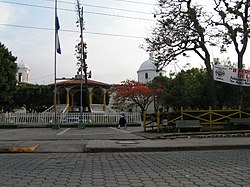Matagalpa, Nicaragua
|
Matagalpa, Nicaragua San Pedro de Matagalpa |
|||
|---|---|---|---|
| Municipality | |||

Matagalpa's Cathedral
|
|||
|
|||
| Location in Nicaragua | |||
| Coordinates: 12°55′N 85°55′W / 12.917°N 85.917°W | |||
| Country |
|
||
| Department | Matagalpa Department | ||
| Area | |||
| • Municipality | 247.36 sq mi (640.65 km2) | ||
| Population (2012) | |||
| • Municipality | 542,000 | ||
| • Metro | 150,643 (4th Nicaragua) | ||
| Climate | Aw | ||
Matagalpa (Spanish pronunciation: [mataˈɣalpa]) is a city in Nicaragua, the capital of the department of Matagalpa. The city has a population of 150,643 (2012 census), while the population of the department is more than 542,000. Matagalpa is Nicaragua's fourth largest city, the largest in the country's interior and one of the most commercially active outside of Managua. Matagalpa is the second most important city in Nicaragua and is known as the "Pearl of the North" and "Land of Eternal Spring."
According to Jeronimo Perez, a historian who visited this area in 1855–1856 the name Matagalpa means Cabeza Principal (Main Head) or Pueblo Grande (Big Town) from the Matagalpa Indian language words: Maika=Head, Calpul* Town- But according to the Matagalpan linguist father Guillermo Kiene, a Catholic priest and missionary who lived from 1898 to 1959, the word Matagalpa comes from the Sumo language, and means "let's go where the rocks are."
There have been other descriptions of the word Matagalpa: -Here next to the water, and -Among Mountains ( "Aqui junto al agua" y "Entre Montañas"). These descriptions are believed to be related to the geographic location of the city, which is next to the Grand River of Matagalpa, and also beautifully surrounded by mountains.
Matagalpa was originally an indigenous village. The Matagalpa Indians had their own language, which has been extinct since 1875. A document from the year 1855 with 97 words and phrases from the Matagalpa language can be found in the Daniel G. Brinton section of the American Philosophical Library in Philadelphia.
The Matagalpa made ceramics of a style known as "Ceramica Negra" and "Naranja Segovia", they also built stone statues representing their chieftain and warriors. They were feared by the Spanish because they were very brave and effective with their bows and other arms. It took 300 years for the Spanish to submit them, even at the time of Nicaragua Independence in 1821 there were many Matagalpa Indians free in the central mountains of Nicaragua. In 1856 they were decisive to defeat William Walker's filibusteers in the Battle of San Jacinto on 14 September 1856, where a column of 60 Matagalpa Indians with bow and arrows fought at the side of Nicaraguan Patriots winning that battle, which marked the end of Walker adventure in Nicaragua. That quest has been recognized by historians and archaeologists, and there is a popular movement to declare the Matagalpa Indians as National Heroes by the Congress of the Republic next month of September 2011.
...
Wikipedia



